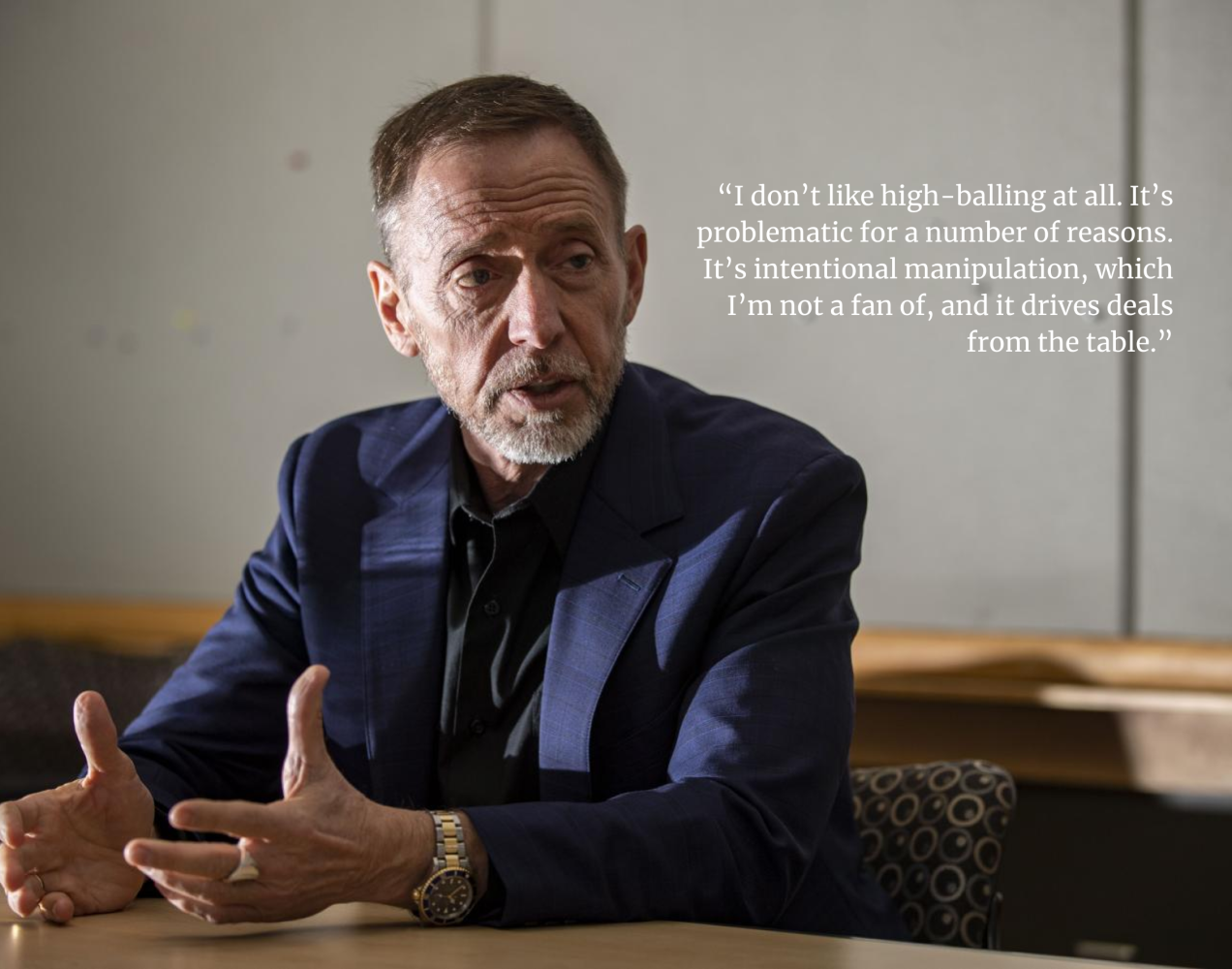In this episode of Meet the CEOs, he joins us to discuss the art of negotiation, particularly in the realm of complex B2B deals, and how to become an expert in this field.
1. ‘No’ is not always a wrong response, despite what many sales experts would have you think
Many other salespeople are taught to remove the word no from their vocabulary and certainly never take it as an answer, focusing on what is referred to as ‘momentum selling’.
In this method, each yes from the client is treated as micro-transaction, and a step closer to a successful deal.
But Chris sees things a little differently and believes that a well-timed no can push negotiations in the right direction.
“Both yes and no, like most things in negotiations, really depend on which side you are on,” Chris states. “Human beings love to hear yes, but we hate to say it. We love to say no, and we hate to hear it. So, if humans hate to say yes, I’m not going to try to get you to say yes, as I know it will make you feel concerned, anxious, and uncomfortable.”
It is this style of negotiation that has allowed Chris to make leads lower their guard and not feel panicked, ultimately building trust and making a deal more likely.
He explains that while sales tactics like momentum selling see each yes as a small win, tying down the prospect, from the prospect's perspective, this can feel like a trap, which makes them panic and worry about what they are getting themselves into.
Instead, Chris explains that not only does he not shy away from a no, he actively seeks it. “Instead of saying, do you have a few minutes to talk? We say, Is now a bad time to talk?” he explains. “Instead of saying do you agree, we say do you disagree? Once you flip into the reality of how safe people feel when they say no, then you simply change your questions, and they become much more collaborative.”
2. Even without many of us realizing, emotions play a huge role in our business-related decision-making
Chris is a big believer in the importance of empathy, but he also knows how important it is to keep things simple.
“Empathy is basically just people smarts,” he explains. “We put the word tactical in front of it because we use concepts from neural science to help us deactivate negative feelings, encourage positive ones, and show how much more agreeable someone can be when they feel heard.”
And it is that approach that Chris recommends for all of his clients. “It’s all about how you transmit information to someone so they feel heard,” he explains. “The results can be astonishing.”
3. Challenges are always lurking under the surface. Rather than avoiding them, try to approach them much earlier in the process
Even when a deal seems like it is all done and dusted, an unforeseen challenge or issue can arise. But Chris has a way of preparing and tackling these problems when they occur.
In fact, he sees these issues, which he refers to as “Black Swans,” as opportunities.
“These black swans actually give you an opportunity to make a better deal” he explains. “In most instances, there have probably been indicators of issues there all along. There’s always information you don’t know. Remember, there’s always information you’re holding back, too. Information you feel may change everything to your disadvantage. So that means they’re holding stuff back, too.”
So, how does Chris suggest you create a better environment early on where this information is shared freely from both sides of the negotiations?
To achieve this, Chris reiterates the importance of the word no. “Some of it comes from getting someone to say no early on,” he states. “Frequently, you will hear something like ‘No, it’s not impossible, but here are the problems, and those black swans (issues) will appear much sooner.
It’s the one time where Chris believes that “but” is not a bad word when people are using it to be open and honest about their problems or challenges.
“Bear in mind that if you’ve been trying to get them to say yes, you’ve been getting reluctant or hesitant yeses,” Chris explains. “Well, that’s an indication of hidden information (black swans), which we also refer to as yellow flags. So, if someone gives you a hesitant yes, I would suggest you follow up and ask what’s bothering them. The sooner those thoughts and fears come out, the sooner they can be resolved, and the sooner a great deal can be made.”

Chris Voss, Former FBI hostage negotiator and CEO & Founder of The Black Swan Group Ltd. Photo: Masterclass.
4. The best sales skill is to listen to your prospects actively
Chris also recommends that salespeople must stay away from the ‘gotcha’ technique. “What many salespeople will do is ask prospects a question that they know will give them any one of three answers, and as soon as they hear what they are waiting for, they think ‘gotcha, I’ve got a solution for that’,” Chris states. “Even if you do have the answers, but you haven’t listened to me or shown me that you are genuinely interested in my needs and concerns, I’m not going to trust you.”
Without trust, prospects are much harder to convert, and the chances of issues getting raised early in the process drop to almost zero.
5. The difference between price anchoring and emotional anchoring
Chris and his team also have a unique approach to pricing their services. “We use emotional anchors, not price anchors,” explains Chris. “I never ask for more than I want. I’ve found that price anchoring drives deals from the table and diminishes relationships.”
So, how does Chris approach the topic of pricing with his prospects?
“Before I give a prospect a price, I tell them ‘look, it’s a lot. You’re probably going to think I’m greedy. You’re probably going to think I don’t deserve it.’ What I’m doing here is emotional anchoring,” he explains. “ I’m preparing you for my position.”
Chris does this so that when he does propose his price, it comes as a relief. By using the language in this way, prospects are expecting his services to cost a ridiculous amount, so when the figure is shared, their natural reaction is often to be pleased, but it is below their expectations.
And on the off chance that it isn’t, they still understand it as it meets their new expectations.

"These black swans actually give you an opportunity to make a better deal." Photo: Masterclass.
6. As a result, Chris is not a fan of ‘high-balling’ initial offers
“I don’t like high-balling at all,” admits Chris. “It’s problematic for a number of reasons. It’s intentional manipulation, which I’m not a fan of, and it drives deals from the table. If someone tries to highball me, I walk away, even in scenarios where they should have been able to make a deal with me.”
Chris also mentions there is the possibility that you may undervalue your services by mistake using this method. “I had a student in Georgetown who went in for a job interview and thought they were making an extreme ask for asking for a salary of $110,000,” he explains. “He later found out that all of his colleagues were getting paid $125,000.”
7. The importance of prioritizing learning in your culture.
When it comes to implementing these new techniques, Chris states that it is crucial that you prioritize space for learning to ensure the team can continue to grow and improve.
“You can conduct a staff-wide training day, but what about if someone isn’t able to make it on that one day?” Chris asks. “By creating space for learning, two things will happen. One is that your employees will be happier, as they get to learn and grow, and two, they’re going to become smarter and more profitable.”

Photo: Ayrton Breckenridge/The Daily Iowan.
8. Long-term partnerships are not always smooth sailing; sometimes, you’ll have a big decision to make
When it comes to fostering long-term business partners, Chris again explains the value of ensuring you come across as a calming influence and someone who genuinely listens to any concerns or queries.
“If my tone of voice is clear, calm, and humble, you are going to be more inclined to work with me to make a better deal,” explains Chris.
Chris also explains that looking for collaborative tendencies in your clients or prospects is also a significant indicator of whether there is long-term potential in the relationship.
If a prospect shows a clear lack of willingness to collaborate, Chris explains that it is then your call as to whether you need to continue working on this deal or whether it would be better to walk away.
“The best indicator of future behavior is past behavior,” he explains. “ Do I want to work with a customer who is always going to make life difficult?”
9. Avoid the temptation to promote urgency
When asked about his thoughts on the fourth-quarter urgency message, which is often used in an attempt to get a deal over the line, Chris is not a fan.
“I don’t like doing it,” he admits. “I think it’s possibly very damaging for the long term. If I start trying to drive urgency, it’s a little more focused on me. I’m becoming much more transactional and much more selfish. As a result, you have less reason to be a good partner to me over the long term.”
That is why Chris recommends avoiding this method and focusing instead on long-term strategy and shifting out of calendar focus into long-term thinking.
10. Don’t take yourself hostage.
Finally, Chris explains that you should never put yourself in a position where you can’t say no or disagree during negotiations. For example, if you have a quarterly deadline to meet, be open and upfront with a potential client about that and offer to walk away if they aren’t going to close within your period.
“I try to take those perceived positions of weakness and turn them into ways to accelerate the deal,” he explains. “Instead of using my deadline as a problem that is trapping me, I use it as a reason to accelerate, or I’m going to have to walk away right now.”

“If my tone of voice is clear, calm, and humble, you are going to be more inclined to work with me to make a better deal”. Photo: Masterclass.









